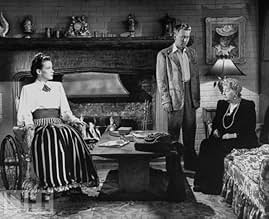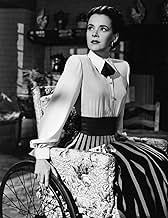Ajouter une intrigue dans votre langueA jealous, manipulative stepmother confined to a wheelchair interferes with her stepchildren's romances so that they will not get married and leave home.A jealous, manipulative stepmother confined to a wheelchair interferes with her stepchildren's romances so that they will not get married and leave home.A jealous, manipulative stepmother confined to a wheelchair interferes with her stepchildren's romances so that they will not get married and leave home.
May Whitty
- Clara Brastock
- (as Dame May Whitty)
Jack Deery
- Engagement Party Attendee
- (non crédité)
Gerald Hamer
- Vicar Woolton
- (non crédité)
Doris Lloyd
- Mrs. Woolton
- (non crédité)
Paul Power
- Engagement Party Attendee
- (non crédité)
Gerald Rogers
- Station Master
- (non crédité)
Paul Scardon
- Perowen
- (non crédité)
Margaret Tracy
- Emily
- (non crédité)
Eric Wilton
- Engagement Party Attendee
- (non crédité)
Histoire
Le saviez-vous
- AnecdotesSusan Peters was on a hunting trip on January 1, 1945 when her rifle accidentally discharged and she was shot. This resulted in her being paralyzed from the waist down. This was the only film she made after the accident.
- GaffesToutes les informations contiennent des spoilers
- Citations
Clara Brastock: Do you really think i'd stay when i'm not wanted?
Mallory St. Aubyn: I think you might.
- Crédits fous"The return to the screen of Miss SUSAN PETERS"
- Bandes originalesI'll Never Say I Love You (to Anyone but You)
Performed by Susan Peters
Written by Allan Roberts and Lester Lee
Commentaire à la une
From the wheelchair to which the actress was confined as the result of a hunting accident three years earlier, Susan Peters builds a controlled, subtle, expert performance that's the centerpiece of John Sturges' The Sign of the Ram. As the paralyzed young stepmother of three children living in a great Gothic pile on the Cornish coast, she conceals her frustrations under a mask of serenity (she writes mawkish poems for a London newspaper under the name Faith Hope) only to unleash them in sly, vindictive manipulation.
The wheelchair may render her immobile, but her hands, restless and expressive, are ever on the move: posturing with cigarettes and lighter, picking out waltzes on the keyboard, plying her pen, knitting and purling. They seem to have a life of their own a slithery, reptilian life, fueled by the cold instincts of the brainstem alone.
The cast around her pulls its weight, too, in particular husband Alexander Knox, best remembered as the president in Darryl Zanuck's overblown biopic Wilson; Phyllis Thaxter as a hired secretary/companion; and Peggy Ann Garner, as an adolescent girl whose warped loyalty to Peters almost has irreversible consequences. Sturges maintains the pace, a brooding andante, while Burnett Guffey coaxes the most out of the labyrinthine house and crashing Irish Sea.
But it's Peter's movie, and her last (she died four years later). When her machinations come to light, with the fog rolling in, Sturges devises a superb final scene a cinematic `schlussgesang,' as they called those overwrought soprano passages that rang down the curtain in German opera. She deserved nothing less.
The wheelchair may render her immobile, but her hands, restless and expressive, are ever on the move: posturing with cigarettes and lighter, picking out waltzes on the keyboard, plying her pen, knitting and purling. They seem to have a life of their own a slithery, reptilian life, fueled by the cold instincts of the brainstem alone.
The cast around her pulls its weight, too, in particular husband Alexander Knox, best remembered as the president in Darryl Zanuck's overblown biopic Wilson; Phyllis Thaxter as a hired secretary/companion; and Peggy Ann Garner, as an adolescent girl whose warped loyalty to Peters almost has irreversible consequences. Sturges maintains the pace, a brooding andante, while Burnett Guffey coaxes the most out of the labyrinthine house and crashing Irish Sea.
But it's Peter's movie, and her last (she died four years later). When her machinations come to light, with the fog rolling in, Sturges devises a superb final scene a cinematic `schlussgesang,' as they called those overwrought soprano passages that rang down the curtain in German opera. She deserved nothing less.
Meilleurs choix
Connectez-vous pour évaluer et suivre la liste de favoris afin de recevoir des recommandations personnalisées
- How long is The Sign of the Ram?Alimenté par Alexa
Détails
- Date de sortie
- Pays d’origine
- Langues
- Aussi connu sous le nom de
- Le signe du bélier
- Lieux de tournage
- Lizard Point, Cornwall, Angleterre, Royaume-Uni(rocky coastline shots)
- Société de production
- Voir plus de crédits d'entreprise sur IMDbPro
- Durée1 heure 24 minutes
- Couleur
- Rapport de forme
- 1.37 : 1
Contribuer à cette page
Suggérer une modification ou ajouter du contenu manquant

Lacune principale
By what name was The Sign of the Ram (1948) officially released in India in English?
Répondre




























